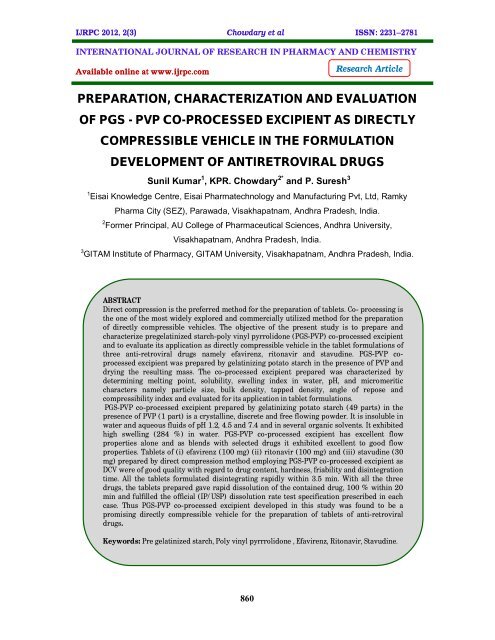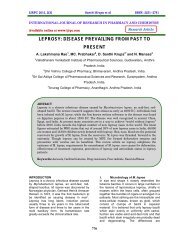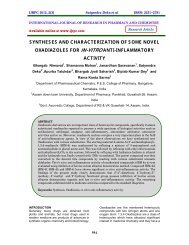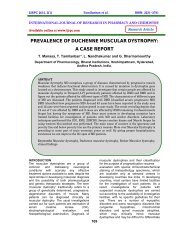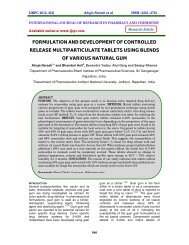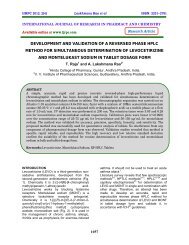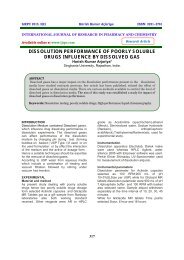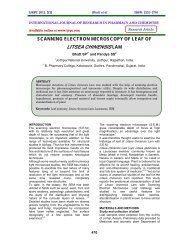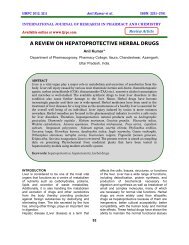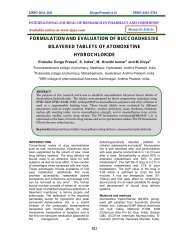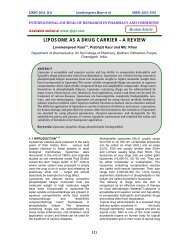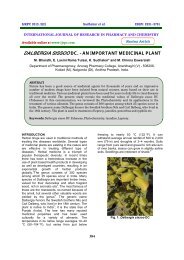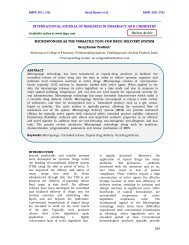preparation, characterization and evaluation of pgs - pvp co ... - ijrpc
preparation, characterization and evaluation of pgs - pvp co ... - ijrpc
preparation, characterization and evaluation of pgs - pvp co ... - ijrpc
You also want an ePaper? Increase the reach of your titles
YUMPU automatically turns print PDFs into web optimized ePapers that Google loves.
IJRPC 2012, 2(3) Chowdary et al ISSN: 22312781<br />
INTERNATIONAL JOURNAL OF RESEARCH IN PHARMACY AND CHEMISTRY<br />
Available online at www.<strong>ijrpc</strong>.<strong>co</strong>m<br />
Research Article<br />
PREPARATION, CHARACTERIZATION AND EVALUATION<br />
OF PGS - PVP CO-PROCESSED EXCIPIENT AS DIRECTLY<br />
COMPRESSIBLE VEHICLE IN THE FORMULATION<br />
DEVELOPMENT OF ANTIRETROVIRAL DRUGS<br />
Sunil Kumar 1 , KPR. Chowdary 2* <strong>and</strong> P. Suresh 3<br />
1 Eisai Knowledge Centre, Eisai Pharmatechnology <strong>and</strong> Manufacturing Pvt, Ltd, Ramky<br />
Pharma City (SEZ), Parawada, Visakhapatnam, Andhra Pradesh, India.<br />
2 Former Principal, AU College <strong>of</strong> Pharmaceutical Sciences, Andhra University,<br />
Visakhapatnam, Andhra Pradesh, India.<br />
3 GITAM Institute <strong>of</strong> Pharmacy, GITAM University, Visakhapatnam, Andhra Pradesh, India.<br />
ABSTRACT<br />
Direct <strong>co</strong>mpression is the preferred method for the <strong>preparation</strong> <strong>of</strong> tablets. Co- processing is<br />
the one <strong>of</strong> the most widely explored <strong>and</strong> <strong>co</strong>mmercially utilized method for the <strong>preparation</strong><br />
<strong>of</strong> directly <strong>co</strong>mpressible vehicles. The objective <strong>of</strong> the present study is to prepare <strong>and</strong><br />
characterize pregelatinized starch-poly vinyl pyrrolidone (PGS-PVP) <strong>co</strong>-processed excipient<br />
<strong>and</strong> to evaluate its application as directly <strong>co</strong>mpressible vehicle in the tablet formulations <strong>of</strong><br />
three anti-retroviral drugs namely efavirenz, ritonavir <strong>and</strong> stavudine. PGS-PVP <strong>co</strong>processed<br />
excipient was prepared by gelatinizing potato starch in the presence <strong>of</strong> PVP <strong>and</strong><br />
drying the resulting mass. The <strong>co</strong>-processed excipient prepared was characterized by<br />
determining melting point, solubility, swelling index in water, pH, <strong>and</strong> micromeritic<br />
characters namely particle size, bulk density, tapped density, angle <strong>of</strong> repose <strong>and</strong><br />
<strong>co</strong>mpressibility index <strong>and</strong> evaluated for its application in tablet formulations.<br />
PGS-PVP <strong>co</strong>-processed excipient prepared by gelatinizing potato starch (49 parts) in the<br />
presence <strong>of</strong> PVP (1 part) is a crystalline, discrete <strong>and</strong> free flowing powder. It is insoluble in<br />
water <strong>and</strong> aqueous fluids <strong>of</strong> pH 1.2, 4.5 <strong>and</strong> 7.4 <strong>and</strong> in several organic solvents. It exhibited<br />
high swelling (284 %) in water. PGS-PVP <strong>co</strong>-processed excipient has excellent flow<br />
properties alone <strong>and</strong> as blends with selected drugs it exhibited excellent to good flow<br />
properties. Tablets <strong>of</strong> (i) efavirenz (100 mg) (ii) ritonavir (100 mg) <strong>and</strong> (iii) stavudine (30<br />
mg) prepared by direct <strong>co</strong>mpression method employing PGS-PVP <strong>co</strong>-processed excipient as<br />
DCV were <strong>of</strong> good quality with regard to drug <strong>co</strong>ntent, hardness, friability <strong>and</strong> disintegration<br />
time. All the tablets formulated disintegrating rapidly within 3.5 min. With all the three<br />
drugs, the tablets prepared gave rapid dissolution <strong>of</strong> the <strong>co</strong>ntained drug, 100 % within 20<br />
min <strong>and</strong> fulfilled the <strong>of</strong>ficial (IP/USP) dissolution rate test specification prescribed in each<br />
case. Thus PGS-PVP <strong>co</strong>-processed excipient developed in this study was found to be a<br />
promising directly <strong>co</strong>mpressible vehicle for the <strong>preparation</strong> <strong>of</strong> tablets <strong>of</strong> anti-retroviral<br />
drugs.<br />
Keywords: Pre gelatinized starch, Poly vinyl pyrrrolidone , Efavirenz, Ritonavir, Stavudine.<br />
860
IJRPC 2012, 2(3) Chowdary et al ISSN: 22312781<br />
INTRODUCTION<br />
Direct <strong>co</strong>mpression is the preferred method for<br />
the <strong>preparation</strong> <strong>of</strong> tablets [1] . It <strong>of</strong>fers several<br />
advantages 2-3 .Notable among them are (i) It is<br />
e<strong>co</strong>nomical <strong>co</strong>mpared to wet granulation since<br />
it requires fewer unit operations (ii) More<br />
suitable for moisture <strong>and</strong> heat sensitive APIs<br />
since it eliminates wetting <strong>and</strong> drying steps (iii)<br />
Changes in dissolution pr<strong>of</strong>ile are less likely to<br />
occur in tablets made by direct <strong>co</strong>mpression<br />
method on storage than in those made from<br />
granulations 4 .This is extremely important<br />
because the <strong>of</strong>ficial <strong>co</strong>mpendium now requires<br />
dissolution specifications in most solid dosage<br />
forms 5 . Disintegration or dissolution is the rate<br />
limiting step in absorption in the case <strong>of</strong> tablets<br />
<strong>of</strong> poorly soluble API prepared by wet<br />
granulation. The tablets prepared by direct<br />
<strong>co</strong>mpression disintegrate into API particles<br />
instead <strong>of</strong> granules that directly <strong>co</strong>me into<br />
<strong>co</strong>ntact with dissolution fluid <strong>and</strong> exhibits<br />
<strong>co</strong>mparatively faster dissolution.<br />
The direct <strong>co</strong>mpression process is mainly<br />
influenced by the properties <strong>of</strong> the excipients.<br />
The physi<strong>co</strong> mechanical properties <strong>of</strong><br />
excipients that ensure a robust <strong>and</strong> successful<br />
process are good flowability, good<br />
<strong>co</strong>mpressibility, low or no moisture sensitivity,<br />
low lubricant sensitivity, <strong>and</strong> good<br />
machineability even in high –speed tabletting<br />
machinery with reduced dwell times 6 . The<br />
majority <strong>of</strong> the excipients that are currently<br />
available fail to give up to these functionality<br />
requirements, thus creating the opportunity for<br />
the development <strong>of</strong> new high-functionality<br />
excipients. An efficient platform for the<br />
manipulation <strong>of</strong> excipient functionality is<br />
provided by <strong>co</strong>-processing two or more<br />
existing excipients. Co-processing is based on<br />
the novel <strong>co</strong>ncept <strong>of</strong> two or more excipients<br />
interacting at the sub particle level, the<br />
objective <strong>of</strong> which is to provide a synergy <strong>of</strong><br />
functionality improvements as well as masking<br />
the undesirable properties <strong>of</strong> individual<br />
excipients 7 . The availability <strong>of</strong> a large number<br />
<strong>of</strong> excipients for <strong>co</strong>-processing ensures<br />
numerous possibilities to produce tailor-made<br />
“designer excipients” to address specific<br />
functionality requirements. Co-processed<br />
excipients are prepared by in<strong>co</strong>rporating one<br />
excipient into the particle structure <strong>of</strong> another<br />
excipient using processes such as <strong>co</strong>-drying.<br />
Co-processing <strong>of</strong> excipients in the<br />
pharmaceutical industry can be dated back to<br />
the late 1980’s with the introduction <strong>of</strong> <strong>co</strong>processed<br />
microcrystalline cellulose <strong>and</strong><br />
calcium carbonate 8 , followed by Cellactose<br />
(Meggle Corp., Wasserburg, Germany) in<br />
1990, which is a <strong>co</strong>-processed <strong>co</strong>mbination <strong>of</strong><br />
cellulose <strong>and</strong> lactose. A similar principle was<br />
applied in developing silicified microcrystalline<br />
cellulose (SPVP), which is the most widely<br />
861<br />
used <strong>co</strong>-processed excipient 9 .The objective <strong>of</strong><br />
the present study is to prepare <strong>and</strong><br />
characterize pregelatinized starch-poly vinyl<br />
pyrrolidone (PGS-PVP) <strong>co</strong>-processed<br />
excipient <strong>and</strong> to evaluate its application as<br />
directly <strong>co</strong>mpressible vehicle in tablet<br />
formulations. PGS-PVP <strong>co</strong>- processed<br />
excipeint was prepared by gelatinizing potato<br />
starch in the presence <strong>of</strong> PVP <strong>and</strong> drying the<br />
resulting mass.<br />
EXPERIMENTAL<br />
Materials<br />
Efavirenz, ritonavir, stavudine <strong>and</strong> poly vinyl<br />
pyrrolidone (PVP) were gift samples from M/s<br />
Eisai Pharmatechnology <strong>and</strong> Manufacturing<br />
Pvt. Ltd., Visakhapatnam. Potato starch,<br />
lactose, talc <strong>and</strong> magnesium stearate were<br />
procured from <strong>co</strong>mmercial sources. All other<br />
materials used were <strong>of</strong> Pharma<strong>co</strong>poeial grade.<br />
METHODS<br />
Preparation <strong>of</strong> PGS-PVP Co-processed<br />
Excipient<br />
Potato starch (49parts) <strong>and</strong> poly vinyl<br />
pyrrolidone (1 part) were dispersed in 20 parts<br />
<strong>of</strong> water to form a smooth slurry. Purified water<br />
(40 parts) was taken in a separate beaker <strong>and</strong><br />
heated to boiling. Starch - PVP slurry was<br />
added to boiling water while stirring. Stirring<br />
while heating was <strong>co</strong>ntinued for 15 to 20<br />
minutes to form a thick mass. The product<br />
formed was <strong>co</strong>llected on to stainless steel tray<br />
<strong>and</strong> dried at 80 o c for 12 hours. The dried<br />
product was grinded <strong>and</strong> sized to obtain -<br />
72+100 mesh sized particles.<br />
Characterization <strong>of</strong> PGS-PVP Co-processed<br />
excipient<br />
PGS-PVP <strong>co</strong>-processed excipient prepared<br />
was characterized by determining melting<br />
point, solubility, swelling index in water, pH,<br />
<strong>and</strong> micromeritic characters namely particle<br />
size, bulk density, tapped density, angle <strong>of</strong><br />
repose <strong>and</strong> <strong>co</strong>mpressibility index <strong>and</strong> by FTIR<br />
spectra.<br />
Solubility<br />
Solubility <strong>of</strong> PGS-PVP was tested in water,<br />
aqueous buffers <strong>of</strong> pH 1.2, 4.5, <strong>and</strong> 7.4 <strong>and</strong><br />
organic solvents such as al<strong>co</strong>hol,<br />
dichloromethane, chlor<strong>of</strong>orm, acetone <strong>and</strong><br />
petroleum ether.<br />
pH<br />
The pH <strong>of</strong> a 1% w/v slurry was measured.<br />
Melting point<br />
Melting point was determined by using melting<br />
point apparatus.
IJRPC 2012, 2(3) Chowdary et al ISSN: 22312781<br />
Swelling Index 10<br />
PGS-PVP (500 mg) was added to 10 ml <strong>of</strong><br />
water <strong>and</strong> light paraffin taken in two different<br />
graduated test tubes <strong>and</strong> mixed. The<br />
dispersion in the tubes was allowed to st<strong>and</strong><br />
for 24 hrs. The volumes <strong>of</strong> the sediment in the<br />
tubes were re<strong>co</strong>rded. The Swelling index <strong>of</strong><br />
the material was calculated as follows.<br />
S.I (%) = (Volume <strong>of</strong> sediment in water –<br />
Volume <strong>of</strong> sediment in light liquid paraffin)/<br />
(Volume <strong>of</strong> sediment in liquid paraffin)<br />
Particle size<br />
Particle size analysis was done by sieving<br />
using st<strong>and</strong>ard sieves.<br />
Bulk density 11<br />
Bulk density (g/cc) was determined by three<br />
tap method in graduated cylinder.<br />
Angle <strong>of</strong> repose 12<br />
Angle <strong>of</strong> repose was measured by fixed funnel<br />
method.<br />
Compressibility index 13<br />
Compressibility index (CI) was determined by<br />
measuring the initial volume (V 0 ) <strong>and</strong> final<br />
volume (V) after hundred tappings <strong>of</strong> a sample<br />
<strong>of</strong> the product in a measuring cylinder.<br />
CI was calculated using equation,<br />
Compressibility index (CI) = [(V 0 -V)/V 0 ] ×100<br />
Preparation <strong>of</strong> Tablets by Direct<br />
Compression Method<br />
Tablets <strong>of</strong> (i) Efavirenz (100 mg) (ii) Ritonavir<br />
(100 mg) <strong>and</strong> (iii) Stavudine (30 mg) were<br />
prepared by direct <strong>co</strong>mpression method as per<br />
the formula given in the Table 2. All the<br />
materials required as per the formula were<br />
blended in a closed polyethylene bag. The<br />
blends were <strong>co</strong>mpressed into tablets on a<br />
tablet punching machine (M/s Cadmach<br />
Machinery Co. Pvt. Ltd.,) to a hardness <strong>of</strong> 6<br />
kg/cm 2 using 9 mm flat punches.<br />
Evaluation <strong>of</strong> Tablets<br />
All the tablets prepared were evaluated for<br />
<strong>co</strong>ntent <strong>of</strong> active ingredient, hardness,<br />
friability, disintegration time <strong>and</strong> dissolution<br />
rate. Hardness <strong>of</strong> tablets was tested using<br />
Monsanto hardness tester. Friability <strong>of</strong> the<br />
tablets was determined in a Roche Friabilator.<br />
Disintegration time was determined in a Lab<br />
India tablet disintegration test machine (model:<br />
DT 1000) using water as test fluid.<br />
Estimation <strong>of</strong> Drug Content in the Tablets<br />
From each batch <strong>of</strong> tablets prepared 20 tablets<br />
were accurately weighed <strong>and</strong> powdered.<br />
Tablet powder equivalent to 50 mg <strong>of</strong> drug was<br />
taken for assay into a 100 ml <strong>co</strong>nical flask <strong>and</strong><br />
862<br />
extracted with 3×20 ml quantities <strong>of</strong> methanol.<br />
The methanolic extracts were filtered <strong>and</strong><br />
<strong>co</strong>llected into a 100 ml volumetric flask <strong>and</strong> the<br />
volume was then made up to 100 ml with<br />
methanol. The solution was then suitably<br />
diluted with water <strong>co</strong>ntaining 2% SLS in the<br />
case <strong>of</strong> efavirenz <strong>and</strong> with 0.1 N hydrochloric<br />
acid in the case <strong>of</strong> ritonavir <strong>and</strong> stavudine. The<br />
absorbance <strong>of</strong> the solutions was measured at<br />
245 nm in the case <strong>of</strong> efavirenz; at 210 nm in<br />
the case <strong>of</strong> ritonavir <strong>and</strong> at 266 nm in the case<br />
<strong>of</strong> stavudine. Drug <strong>co</strong>ntent <strong>of</strong> the tablets was<br />
calculated using the st<strong>and</strong>ard calibration curve<br />
in each case.<br />
Dissolution Rate Study<br />
Dissolution rate <strong>of</strong> the tablets prepared was<br />
studied employing USP 8 station Dissolution<br />
Rate Test Apparatus (M/s Labindia Disso<br />
8000) with a paddle stirrer at 50 rpm. Water<br />
<strong>co</strong>ntaining 2% SLS (900 ml), hydrochloric acid,<br />
0.1N (900 ml) <strong>and</strong> 0.01 M hydrochloric acid<br />
(900 ml) were used as dissolution fluids for<br />
efavirenz, ritonavir <strong>and</strong> stavudine respectively.<br />
One tablet was used in each test. A<br />
temperature 37±1 0 C was maintained<br />
throughout. Samples <strong>of</strong> dissolution medium (5<br />
ml) were withdrawn through a filter (0.45 µ) at<br />
different time intervals <strong>and</strong> assayed for<br />
efavirenz at 245 nm, ritonavir at 210 nm <strong>and</strong><br />
stavudine at 266 nm. All the dissolution<br />
experiments were <strong>co</strong>nducted in triplicate (n=3).<br />
RESULTS AND DISCUSSION<br />
Directly <strong>co</strong>mpressible vehicles can be<br />
prepared by various methods [14-16] . Coprocessing<br />
is the one <strong>of</strong> the most widely<br />
explored <strong>and</strong> <strong>co</strong>mmercially utilized method for<br />
the <strong>preparation</strong> <strong>of</strong> directly <strong>co</strong>mpressible<br />
vehicles. Co-processing <strong>of</strong> excipients <strong>co</strong>uld<br />
lead to the formation <strong>of</strong> excipients with<br />
superior properties <strong>co</strong>mpared to the simple<br />
physical mixtures <strong>of</strong> their <strong>co</strong>mponents. The<br />
objective <strong>of</strong> the present study is to prepare <strong>and</strong><br />
characterize pregelatinized starch-poly vinyl<br />
pyrrolidone (PGS-PVP) <strong>co</strong>-processed<br />
excipient <strong>and</strong> to evaluate its application as<br />
directly <strong>co</strong>mpressible vehicle in tablet<br />
formulations.<br />
PGS-PVP <strong>co</strong>-processed excipient was<br />
prepared by gelatinizing potato starch (49<br />
parts) in the presence <strong>of</strong> PVP (1 part).The<br />
prepared PGS-PVP <strong>co</strong>-processed excipient<br />
was characterised by determining various<br />
physical <strong>and</strong> micromeritic properties. The<br />
PGS-PVP <strong>co</strong>-processed excipient prepared<br />
was found to be crystalline, discrete <strong>and</strong> free<br />
flowing powder. It <strong>co</strong>uld be ground to various<br />
particle sizes by grinding in a dry mortar.<br />
Particles <strong>of</strong> size -72+100 mesh (179.5 µm)<br />
were <strong>co</strong>llected <strong>and</strong> used for further studies.<br />
The physical <strong>and</strong> micromeritic properties <strong>of</strong>
IJRPC 2012, 2(3) Chowdary et al ISSN: 22312781<br />
PGS-PVP <strong>co</strong>-processed excipient prepared<br />
are summarised in Table 1.<br />
Table 1: Physical <strong>and</strong> Micromeritic Properties <strong>of</strong><br />
PGS-PVP Co-processed Excipient<br />
S.No.<br />
1.<br />
Property/Test<br />
Melting point<br />
Result<br />
Charred at 250 0 c<br />
2. Solubility<br />
Insoluble in water, methanol,<br />
al<strong>co</strong>hol, acetone, chlor<strong>of</strong>orm,<br />
dichloromethane <strong>and</strong><br />
petroleum ether<br />
3. Swelling Index (%)<br />
High swelling in water<br />
Swelling index 284 %<br />
4.<br />
pH (1% aqueous<br />
dispersion)<br />
6.8<br />
5. Particle size (µm) 72/100 mesh (179.5 µm)<br />
6. Bulk density (g/cc) 0.436<br />
7. Tapped density (g/cc) 0.464<br />
8. Angle <strong>of</strong> repose ( o ) 24.40<br />
9. Compressibility index (%) 7.8<br />
The PGS-PVP <strong>co</strong>-processed excipient<br />
prepared was charred at 250 0 C.It is insoluble<br />
in water <strong>and</strong> aqueous fluids <strong>of</strong> pH 1.2, 4.5 <strong>and</strong><br />
7.4 <strong>and</strong> also in several organic solvents such<br />
as al<strong>co</strong>hol, methanol, dichloromethane,<br />
acetone, chlor<strong>of</strong>orm <strong>and</strong> petroleum ether. It<br />
exhibited high swelling in water <strong>and</strong> the<br />
swelling index was found to be 284%.<br />
The flow properties <strong>of</strong> the PGS-PVP <strong>co</strong>processed<br />
excipient prepared were<br />
determined by measuring bulk density, angle<br />
<strong>of</strong> repose <strong>and</strong> <strong>co</strong>mpressibility index. The<br />
results given in Table 1 indicated that the<br />
excipient prepared has excellent flow<br />
properties. A directly <strong>co</strong>mpressible vehicle<br />
should be free flowing. Flowability is required<br />
in order ensure homogeneous <strong>and</strong> rapid flow<br />
<strong>of</strong> powder for uniform die filling. During the<br />
short dwell-time (millise<strong>co</strong>nds), the required<br />
amount <strong>of</strong> powder blend should be transferred<br />
into die cavities with reproducibility <strong>of</strong> ± 5%. As<br />
the PGS-PVP <strong>co</strong>-processed excipient<br />
possesses excellent flow properties, it is<br />
<strong>co</strong>nsidered as a promising directly<br />
<strong>co</strong>mpressible vehicle for direct <strong>co</strong>mpression <strong>of</strong><br />
tablets. Blends <strong>of</strong> PGS-PVP <strong>co</strong>-processed<br />
excipient <strong>and</strong> selected drugs (efavirenz,<br />
ritonavir <strong>and</strong> stavudine) also exhibited<br />
excellent to good flow properties. The<br />
estimated bulk density values <strong>of</strong> PGS-PVP <strong>co</strong>processed<br />
excipient would also <strong>co</strong>ntribute to<br />
its good flow.<br />
To evaluate the PGS-PVP <strong>co</strong>-processed<br />
excipient as directly <strong>co</strong>mpressible vehicle<br />
(DCV), tablets <strong>of</strong> (i) efavirenz (100 mg) (ii)<br />
ritonavir (100 mg) <strong>and</strong> (iii) stavudine (30 mg)<br />
were prepared by direct <strong>co</strong>mpression method<br />
employing PGS-PVP <strong>co</strong>-processed excipient<br />
as DCV at strength <strong>of</strong> 60% in the formula. The<br />
tablets were prepared as per the formulae<br />
given Table 2. All the tablets prepared were<br />
evaluated for <strong>co</strong>ntent <strong>of</strong> active ingredient,<br />
hardness, friability, <strong>and</strong> disintegration time <strong>and</strong><br />
dissolution rate. The results are given in Table<br />
3. Hardness <strong>of</strong> the tablets was in the range 4.0<br />
- 5.0 Kg/sq.cm. Weight loss in the friability test<br />
was in the range 1.45 – 2.10%.The drug<br />
<strong>co</strong>ntent <strong>of</strong> the tablets was within 100 ± 3% <strong>of</strong><br />
the labelled claim. All the tablets formulated<br />
disintegrating rapidly within 3.5 min. As such<br />
all the tablets prepared employing the PGS-<br />
PVP <strong>co</strong>-processed excipient were <strong>of</strong> good<br />
quality with regard to drug <strong>co</strong>ntent ,hardness,<br />
friability <strong>and</strong> disintegration time.<br />
Table 2: Formulae <strong>of</strong> Tablets Prepared By Direct Compression<br />
Method Employing PGS-PVP Co- processed Excipient<br />
Ingredient<br />
(mg/tablet)<br />
Tablet Formulation<br />
Efavirenz Ritonavir Stavudine<br />
Efavirenz 100 - -<br />
Ritonavir - 100 -<br />
Stavudine - - 30<br />
PGS-PVP<br />
Co-processed excipient 264 264 264<br />
(72/100 mesh)<br />
Lactose 58.4 58.4 128.4<br />
Talc 8.8 8.8 8.8<br />
Magnesium stearate 8.8 8.8 8.8<br />
Tablet weight (mg) 440 440 440<br />
863
IJRPC 2012, 2(3) Chowdary et al ISSN: 22312781<br />
Table 3: Physical Properties <strong>of</strong> Various Tablets Prepared<br />
By Direct Compression Method Employing<br />
PGS-PVP Co-processed Excipient<br />
Formulation<br />
Hardness<br />
(kg/sq.cm)<br />
Friability<br />
(% weight<br />
loss)<br />
Disintegration<br />
time<br />
(min-sec)<br />
Drug <strong>co</strong>ntent<br />
(mg/tablet)<br />
Efavirenz tablets 4.0 1.45 3-00 98.5<br />
Ritonavir tablets 5.0 2.10 3-15 99.2<br />
Stavudine tablets 5.0 1.95 3-20 101.6<br />
The results <strong>of</strong> the dissolution rate study are<br />
given in Table 4.With all the three drugs, the<br />
tablets prepared gave rapid dissolution <strong>of</strong> the<br />
<strong>co</strong>ntained drug. The dissolution was <strong>co</strong>mplete<br />
(100 %) within 20 min <strong>and</strong> fulfilled the <strong>of</strong>ficial<br />
(IP/USP) dissolution rate test specification<br />
prescribed in each case.<br />
Table 4: Dissolution Rate <strong>of</strong> Various Tablets Formulated by Direct<br />
Compression Method Employing<br />
PGS-PVP Co-processed Excipient Prepared<br />
Formulation<br />
Percent Drug Dissolved (%) at<br />
Time (min)<br />
5 10 15 20<br />
Efavirenz tablets 74.50 88.50 97.20 100<br />
Ritonavir tablets 78.40 98.80 99.90 100<br />
Stavudine tablets 71.62 100 100 100<br />
Official Dissolution Rate<br />
Specification<br />
NLT 70 % in 60 min in<br />
water <strong>co</strong>ntaining 2% SLS<br />
(I.P, 2010)<br />
NLT 75 % in 60 min in 0.1<br />
N HCl<br />
(I.P, 2010)<br />
NLT 70 % in 45 min in<br />
0.01 M HCl<br />
(I.P, 2010)<br />
CONCLUSION<br />
PGS-PVP <strong>co</strong>-processed excipient prepared by<br />
gelatinizing potato starch (49 parts) in the<br />
presence <strong>of</strong> PVP (1 part) is a crystalline,<br />
discrete <strong>and</strong> free flowing powder. It is insoluble<br />
in water <strong>and</strong> aqueous fluids <strong>of</strong> pH 1.2, 4.5 <strong>and</strong><br />
7.4 <strong>and</strong> in several organic solvents. It exhibited<br />
high swelling (284%) in water. PGS-PVP <strong>co</strong>processed<br />
excipient has excellent flow<br />
properties alone <strong>and</strong> as blends with selected<br />
drugs it exhibited excellent to good flow<br />
properties. Tablets <strong>of</strong> (i) efavirenz (ii) ritonavir<br />
<strong>and</strong> (iii) stavudine prepared by direct<br />
<strong>co</strong>mpression method employing PGS-PVP <strong>co</strong>processed<br />
excipient as DCV were <strong>of</strong> good<br />
quality with regard to drug <strong>co</strong>ntent, hardness,<br />
friability <strong>and</strong> disintegration time. All the tablets<br />
formulated disintegrating rapidly within 3.5<br />
min. With all the three drugs, the tablets<br />
prepared gave rapid dissolution <strong>of</strong> the<br />
<strong>co</strong>ntained drug, 100 % within 20 min <strong>and</strong><br />
fulfilled the <strong>of</strong>ficial (IP/USP) dissolution rate<br />
test specification prescribed in each case.<br />
Thus PGS-PVP <strong>co</strong>-processed excipient<br />
developed in this study was found to be a<br />
promising directly <strong>co</strong>mpressible vehicle for the<br />
<strong>preparation</strong> <strong>of</strong> tablets <strong>of</strong> antiretroviral drugs.<br />
REFERENCES<br />
1. Shangraw RF. Direct Compression<br />
Tableting, Encyclopedia <strong>of</strong><br />
Pharmaceutical Technology.<br />
Newyork: Marcel Dekker, USA, Edition<br />
2, Vol.4, 1988: 85-160.<br />
2. Armstrong NA. Selection <strong>of</strong> excipients<br />
for direct <strong>co</strong>mpression tablet<br />
formulation. Pharm.Technol.Eur.1989;<br />
24-30.<br />
3. Jivraj M, Martini LG <strong>and</strong> Thomson CM.<br />
An Overview <strong>of</strong> the Different<br />
Excipients Useful for the Direct<br />
Compression <strong>of</strong> Tablets. PSTT.<br />
2000;3:58-63.<br />
4. Rubinstein MH: Tablets.<br />
Pharmaceutics: The Science <strong>of</strong><br />
Dosage <strong>of</strong> Form. Churchill, UK, Edition<br />
1, 1998;304-321.<br />
5. Banker UV. Role <strong>of</strong> Ingredients <strong>and</strong><br />
Excipients in Developing<br />
Pharmaceuticals. Manuf Chem.1994;<br />
65: 32-34.<br />
6. Armstrong NA <strong>and</strong> Palfrey LP. The<br />
Effect <strong>of</strong> Machine Speed on the<br />
Consolidation <strong>of</strong> Four Directly<br />
Compressible Tablet Diluents. J<br />
Pharm Pharma<strong>co</strong>l. 1989;41:149-151.<br />
864
IJRPC 2012, 2(3) Chowdary et al ISSN: 22312781<br />
7. Reimerdes D.The Near Future <strong>of</strong><br />
Tablet Excipients. Manufacturing<br />
Chemist. 1993; 64(7):14-15.<br />
8. Dev KM. Coprocessed<br />
Microcrystalline Cellulose <strong>and</strong> Calcium<br />
Carbonate <strong>and</strong> Its Preparation. US<br />
Patent No.4, 744, 987 to FMC<br />
Corporation (Philadelphia,PA) 1988.<br />
9. Bolhius GK <strong>and</strong> Chowhan ZT.<br />
Materials for Direct Compaction.<br />
Pharmaceutical Powder Compaction<br />
Technology. G.Alderborn <strong>and</strong><br />
C.Nystron, Eds. Marcel Dekker Inc.,<br />
New York, NY, 1996;419-500.<br />
10. Chowdary KPR <strong>and</strong> Sunil Kumar.<br />
Formulation development <strong>of</strong> selected<br />
drugs by direct <strong>co</strong>mpression method.<br />
IJPRD. 2011;3(6):273-279.<br />
11. Martin A: Physical Pharmacy.<br />
Lippin<strong>co</strong>tt Williams &Wilkins.<br />
Baltimore, 2001:423-454.<br />
12. Cooper J <strong>and</strong> Gunn C. Powder flow<br />
<strong>and</strong> <strong>co</strong>mpaction. Tutorial Pharmacy.<br />
CBS Publications, New Delhi,<br />
India.1986;211-233<br />
13. Aulton ME <strong>and</strong> Wells TI:<br />
Pharmaceutics; The Science <strong>of</strong><br />
dosage form design. Churchill<br />
Livingstone, London, Engl<strong>and</strong>, Edition<br />
2,1988;89-90.<br />
14. Reimedes D. The Near Future <strong>of</strong><br />
Tablet Excipients. Manuf chem.<br />
1993;64:14-15.<br />
15. Shangraw RF, Wallace JW <strong>and</strong> Bowes<br />
FM. Morphology <strong>and</strong> functionality in<br />
Tablet Excipients for Direct<br />
Compression. Pharm. Technol.<br />
1987;11:136-143.<br />
16. Bolhuis GK <strong>and</strong> Chowhan ZT.<br />
Materials for Direct Compression.<br />
Pharmaceutical Powder Compaction<br />
Technology. Marcel Dekker, USA.<br />
1996:7:419-499.<br />
865


